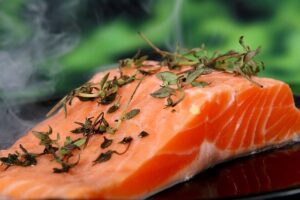Introduction
Eating a high-protein diet has become increasingly popular among fitness enthusiasts and athletes. Protein is essential for building and repairing tissues, supporting muscle growth, and maintaining overall health. While the recommended daily intake of protein is around 0.8 grams per kilogram of body weight, some individuals may require higher amounts, such as those engaged in intense physical activity or aiming for muscle gain. This article will explore strategies on how to consume 300 grams of protein a day.
Calculating Protein Needs
Before diving into the strategies, it’s important to calculate your specific protein needs. To determine how much protein you should consume daily, multiply your body weight in kilograms by the desired protein intake in grams. For example, a person weighing 80 kilograms aiming for 300 grams of protein per day would calculate it as follows: 80 kg x 300 g = 24,000 g or 24 kilograms of protein per day.
Spread Protein Intake Throughout the Day
To efficiently consume 300 grams of protein, it is advisable to spread your protein intake throughout the day. Aim to have protein-rich foods in every meal and snack. This approach ensures a steady supply of amino acids for muscle repair and growth. Consider dividing your protein intake into 5-6 smaller meals or snacks, rather than relying solely on three large meals.
Choose Protein-Dense Foods
To meet a high protein goal, it is crucial to choose protein-dense foods. Opt for lean sources of protein such as chicken breast, turkey, fish, lean beef, tofu, eggs, and low-fat dairy products. These foods provide a significant amount of protein per serving while minimizing the intake of unhealthy fats and excessive calories.
Supplement with Protein Powders
In some cases, it may be challenging to consume 300 grams of protein solely through whole foods. Protein powders can be a convenient and effective way to supplement your protein intake. Whey protein, casein protein, and plant-based protein powders are popular options. They can be easily mixed with water or added to smoothies, providing a concentrated source of protein.
Include Protein in Every Meal
To reach your protein goal, make sure to include protein in every meal. For breakfast, consider options like Greek yogurt, cottage cheese, or protein-packed smoothies. At lunch and dinner, incorporate lean meats, fish, or plant-based protein sources. Snacks such as protein bars, nuts, or protein shakes can also contribute to your daily protein intake.
Plan Ahead and Meal Prep
Meal planning and preparation can be instrumental in achieving a high-protein diet. Take time to plan your meals and snacks in advance, ensuring that they contain adequate protein. Prepare protein-rich meals in bulk and store them in portioned containers for easy access throughout the week. This strategy helps you stay on track and avoid relying on unhealthy, protein-poor options when hunger strikes.
Conclusion
Consuming 300 grams of protein a day requires careful planning and dedication. Spread your protein intake throughout the day, choose protein-dense foods, and consider supplementing with protein powders when necessary. Remember to include protein in every meal and snack, and take advantage of meal planning and preparation to stay on track. As always, consult with a healthcare professional or registered dietitian before making any significant changes to your diet.
References
– Mayo Clinic: mayoclinic.org
– National Institutes of Health: nih.gov
– Academy of Nutrition and Dietetics: eatright.org












